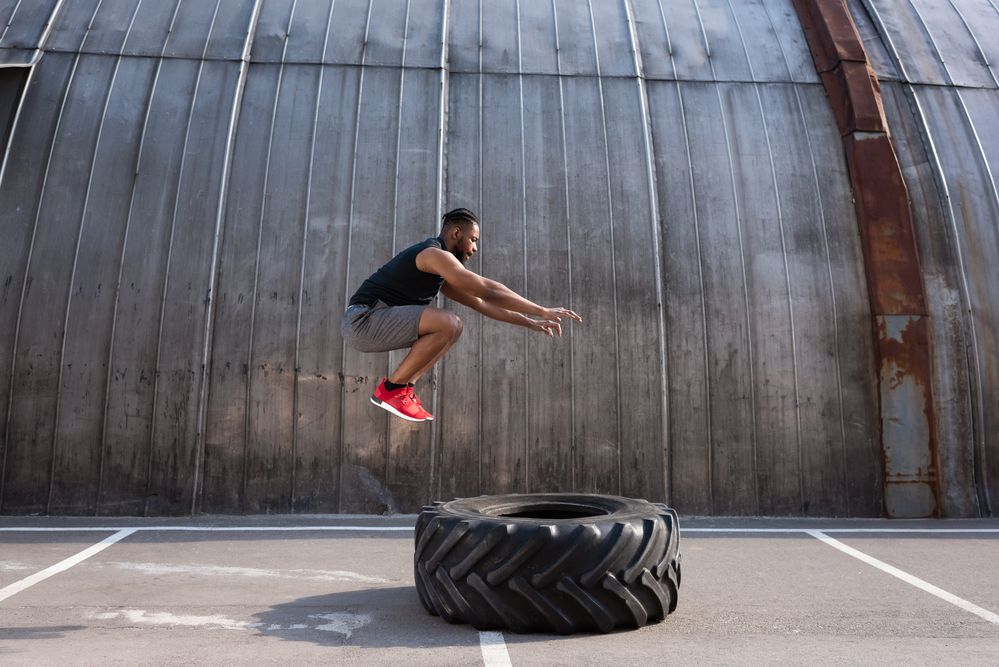This is part of our series of blogs on the posterior chain. In this blog, we’ll take a detailed look at the best posterior chain exercises for jumping and sports or movements that benefit from this explosive power from your muscles.
Who might want to improve their jumping ability?
The concept of jumping, although very ‘athletic’ in nature, can provide a huge benefit for the general population.
We are training the individual to generate force through a strong and stable body, store that force through a system of tendons and elastic energy stored in muscles, then drive that force into the ground to ‘jump’.

This process involves a healthy integration of the feet, ankles, knees, hips, lower back and all surrounding musculature.
This skill and robustness of the body is essential to the longevity of joints, muscular health and in a more real life scenario; has a very positive impact on us not ‘breaking’ when we take a wobble or step down from a surface that’s a little too high.
The posterior chain muscles refer to the muscles at the back of the body – often known as the ‘athletic muscles’.
More specific to jumping, we are talking about the involvement of calves, hamstrings, glutes and the lower back muscles (spinal erectors).
Why are posterior chain exercises important if you want to improve your jumping ability?
These muscles are often neglected in most people’s training routines, likely because we can’t ‘see them’ when training.
Who wants to train muscles we can’t see in the mirror!
To improve jumping ability, we need to be POWERFUL. This is obvious to see when you look at the stature of a track and field athlete; huge glutes, well developed calves and strong hamstrings.
The problem general pop faces is that the ‘sedentary’ lifestyle requires very little input from these muscles. Sitting at a desk all day tends to leave people suffering from dormant glutes, and very relaxed hip flexors.
Disaster for anything that’s even slightly athletic!
Before we can develop hugely powerful posterior chain muscles and practise our slam dunks, we need to establish a level of condition that allows them to be challenged further.
Think of the following exercises at the ‘foundations’ to a powerful posterior chain;
Supine Glute Bridge (Bodyweight Pelvic Bridge)
Easy to progress, starting with an isometric hold, and progressing through to single leg & weighted variations. There is an option for every experience level.
How do I do it?
- Lay on your back with your knees bent.
- Lock your ribs down with your abs.
- Tuck your tailbone between your knees.
- Raise hips without arching your back.
Why is it good for me?
The supine glute bridge is a great way to integrate the stability from ankle, knee and hip whilst challenging the glute and hamstring muscles to complete hip extension.
How do I make it harder?
You can progress the movement to a hip thrust, which is essentially the same movement pattern with a larger range of motion. Start with the back resting against a bench, lined up just below shoulder blades, and bridge the hips up into a fully extended position.
45 Degree Hyperextension
The 45 degree extension provides a challenging stimulus for the athletic muscles. Easy to train with isometric holds, additional load or manipulating tempo.
How do I do it?
- Set up a bar in the squat rack just below hip height, place a ‘squat sponge’ on the bar so you have some protection against the bar.
- Secure your feet against two dumbbells, and lean forward until the bar is resting just below the hip crease. Depending on leg length/ squat rack set up, you may need to also stand on a weight plate.
- Keeping a neutral spine, begin by highing forward over the bar until you’re upper body gets just below parallel to the floor.
- Drive hips into the bar to raise yourself back up to starting position.
Why is it good for me?
Teaches the trainee to complete full hip extension whilst keeping hips and rib cage stacked, and maintaining a neutral spine. Fundamental movement principles to reduce injury risk and challenge the body as one whole unit.
How do I make it easier?
Start with isometric holds. Full benefit of practicing hip extension, minus the need to control muscles through lengthening and shortening phases. Great for conditioning the body to perform the full movement
How do I make it harder?
Manipulate where load is held to really progress this moment. The further the weight is away from hips, the more challenging it will be. Holding a weight plate at the chest is a great starting point to performing a loaded extension.
Coaches top tip?
Ensure you maintain a posterior pelvic tilt when performing this movement, this will allow you to fully contract the glutes at the top of the movement.
Barbell RDL/ Trap Bar RDL
How do I do it?
- Stand with your feet about hip-width apart, holding a barbell.
- Engage your abs to pull your ribs downward and tuck your tailbone under.
- Lower the bar while pushing your hips back and loading a light stretch into your hamstrings.
- Keep your weight on your heels, your feet straight forward and your knees straight over your little toes.
- Pull upward while maintaining good positioning with a neutral spine and weight on your heels.
For a quick trap bar RDL demonstration, check out the following video:
For an extended tutorial on the full RDL progression – check out the following video:
How do I make it easier?
You may find the Dumbbell variation easier – often having the bar placed in front of the body can cause the shoulders to excessively round forwards, leading to excessive flexion of the spine. With dumbbells, you have a bit more control of where they are places, and will find it easier to keep the neutral spine position.
How do I make it harder?
Adding a resistance band around the hips, and attached to something fixed behind you means that the glutes will be challenged significantly more when you reach full hip extension at the top of the movement.
Coaches top tip?
Think about driving the hips backwards, rather than folding forwards. This will ensure the hamstring and glutes are working rather than flexing through the lower spine!
What Else Do You Need to Know?
Most important to bear in mind, jumping is an athletic movement based on producing power.
The typical training structure of 3 x 12 reps, although effective for some goals, is not the whole picture for power training.
The trainee should prioritise building a solid base of strength in the ‘athletic muscles’, then challenge them with moderate to high loads on the lower end of rep scale, with the intention of a ‘powerful’ execution.
This means performing fast reps with a moderate to heavy load.
Safety First
Remember, the movements and techniques you see demonstrated here are advanced exercises, and our team has practised them countless thousands of times. It’s always a good idea to have professional guidance when you’re exercising – and this is especially true when you’re using free weights.
If you’d like to talk to us about training with us here in London at our Soho, Fitzrovia, or Mayfair studios, we’d love to help. Equally, if you’re somewhere else in the world – we can be by your side virtually using our innovative online training app and video call guidance.
